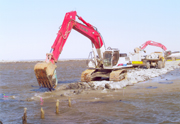|
|||||
Holding Back the Storms’ Surge
|
 |
 |
|
Jason Griffins in the cockpit of The Shoe, above, a small orange tugboat used as a workboat and to transport the crew and small equipment to the worksite at the jetty. A larger tug, bottom, pushes a barge with the crew’s excavators and 25-ton off-road dump truck. |
more than three years of talking, meeting, lawmaking and money seeking.
That the pair is rising is certain.
Through all of Herring Bay, you can hear them rising as excavators pluck and strategically place monoliths in 39-foot-wide rows, one 894 feet long, the other 917 feet long.
Any day now, the finished pair of breakwaters will stand up to seven feet of solid stone above the water. In all, 25,000 tons of rock have been dropped into place.
To put all that stone in place we’re paying $3.73 million, a federal appropriation secured by Congressman Steny Hoyer.
A project that expensive needs a big title. This one is called Rockhold Creek, Second 107, Small Navigation Project, Anne Arundel County, Maryland W912DR-05-C-0030.
Big Machines
First came big machines. Three push-tugs each manipulated a barge into place as a floating platform for the working machinery: one 25-ton Volvo off-road dump truck and five hydraulic excavators, several equipped with Lemac Excavator Thumbs.
A heavy john boat shuttled workers to the platforms. Supporting the work were a 21-foot surveying boat, a Boston Whaler powered by two 200-horsepower Yahama outboards; and a Privateer runabout, powered by a 90-horsepower outboard.
Meanwhile, Coastal Design & Construction Inc., Gloucester, Virginia, set up a portable project base out of an Allied Construction Trailer at Town Point.
 |
The first job for men
and machines was dredging. From November 2005 to February 2006, Bay muck from as deep as 15 feet was lifted from the base of the original 1939 jetty to clear a solid foundation for the new height and weight of rock. At the same time, the Town Point shore was dredged for the new sister jetty.
“It was like digging up rock,” said an operator as up to 20 men worked through rain, sleet, ice, rough seas and high winds, navigating new waters with unfamiliar tidal extremes.
Heavy Rock
Next came the rock, brought by barge from a quarry above Havre de Grace, where the Susquehanna River flows into the Chesapeake.
The scraped bottoms were covered with Number Three stone topped by black plastic-like Geotextile, secured by core stones of 170 to 300 pounds each and capped with armor stone.
Then, from mid-January into March of this year, the old jetty rose, with each rock strategically laid to guarantee stability. Next, from March through May, the new jetty rose.
 |
Intermediate stones, each weighing from 200 to 1,000 pounds are laid first. These are capped with giant armor stones, weighing from 1,500 to 3,000 pounds.
The weight of so much rock wore down the equipment’s claws, thumbs and buckets, keeping welders busy on the barges.
C.L. Harbaugh’s family fought in the Revolutionary War, built the Patowmack (later Potomac) Canal, the original Capitol (and later rebuilt it after the British burned it) and many more buildings in early Washington and Baltimore. He grew up on the Bay in Havre de Grace, where he took up photography in high school. He traveled the world with the Navy and now lives in Town Point. He says that with his photography, he tries to capture history before we lose it. This is his first story for Bay Weekly. Reach him at [email protected].


